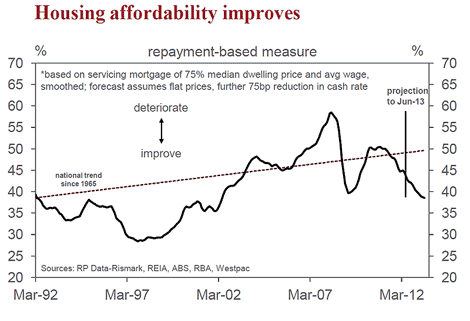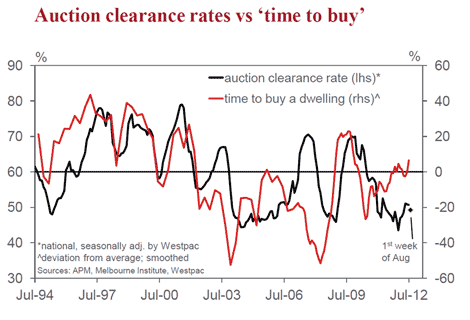RBA cash rate cuts provide “ballast” to "badly listing" housing market: Westpac’s Matthew Hassan
The decision by the RBA to start reducing interest rates in November last year has added “ballast” to a housing market that was “starting to list quite badly”, according to Westpac senior economist Matthew Hassan.
Writing in Westpac’s August Market Insights report, Hassan points to a number of signs that “after a shaky start, Australia’s housing markets are now showing more convincing signs of stabilising”.
Click to enlargeHe says the 125-basis-point cut from the cash rate since November last year has eased the pressure on those servicing existing mortgages, while affordability is near decade-best levels for prospective buyers.
“With rates now on the ‘easy’ side of neutral, the pressure is easing on the mortgage belt – mortgage arrears appear to have peaked and, on the basis of interest rates and incomes at least, should start to track lower from here.
“Housing affordability is also greatly improved with would-be buyers enjoying the most conducive mix of prices, interest rates and incomes since 2003 (excluding the ‘ultra-low’ rate settings in 2009),” says Hassan.
Consumer attitudes are also changing, with Hassan pointing to the results of the Westpac-Melbourne Institute Consumer Sentiment survey “showing consumers starting to warm to real estate again”, setting the scene for a housing market recovery.
“Views on whether now is a good time to buy a dwelling (a sub-index of the Westpac-Melbourne Institute Consumer Sentiment survey) are now at relatively upbeat levels that have led upturns in the past.
Click to enlarge“Fears of house price declines are also subsiding with a notable uptick in the proportion nominating ‘real estate’ as the wisest place for savings, a tentative sign of renewed investor interest," he says.
“Sentiment is an important catalyst for generating a sustained upturn.”
However, Hassan warns of “significant headwinds to a housing recovery in Australia”.
He says the most powerful headwind to a housing recovery is household deleveraging.
“Despite five years of restraint, household debt levels remain near historic highs. Housing upturns usually go hand in hand with rising household leverage.
“This does not preclude a recovery – the rebound in 2009-10 showed housing can still have an up-cycle – but it does mean any recovery that does eventuate will be harder to sustain.
Hassan expects that when the market recovers, "trend price growth" will be below 5% per annum.
He also warns that while sentiment is positive on housing, “sentiment remains much weaker on other aspects crucial to the home buying decision: job loss fears remain very high and consumers’ financial attitudes are still firmly fixed on conservative/defensive risk-averse and debt-averse behaviour”.
“With labour markets and the global financial system likely to remain unsettled in 2012, these factors will continue to deter many potential buyers – both owner-occupiers and investors,” he adds.
As a result, Hassan expects the current housing cycle to show a “much bumpier, more gradual transition from stabilisation to a recovery that is likely to be relatively lacklustre by historical standards”.
But the overall picture is of markets “clearly stabilising” with all price measures recording a moderation in declines with most up slightly for the year to date, says Hassan.
Click to enlargeOther positive indicators, he says are:
- “Annual price inflation across ‘all dwelling’ measures ranges from –2.7% to –1.1% with annualised six month growth rates of between –1.2% and +1.9%.
- “Auction markets are telling a similar story with clearance rates up about 7 percentage points from their February lows.
- “Housing loan approvals have also moved off recent lows for both owner-occupiers and investors and dwelling approvals have snapped out of what was looking like a disturbing drop-off between August and April.
Hassan notes that some of these readings may be being skewed by state government policy changes.
“The NSW, Victoria, Queensland and South Australia state governments all made significant changes to bonus and concession schemes for first home buyers and/or those building new dwellings.
“Several of these were introduced around June/July and would have encouraged buyers and builders to bring forward activity into the first half of the year.
“As such recent finance and dwelling approvals may be overstating strength a little and price measures may also have been impacted (skewed lower during ‘pull forward’ periods with a statistical ‘bounce’ as this effect drops out)."



